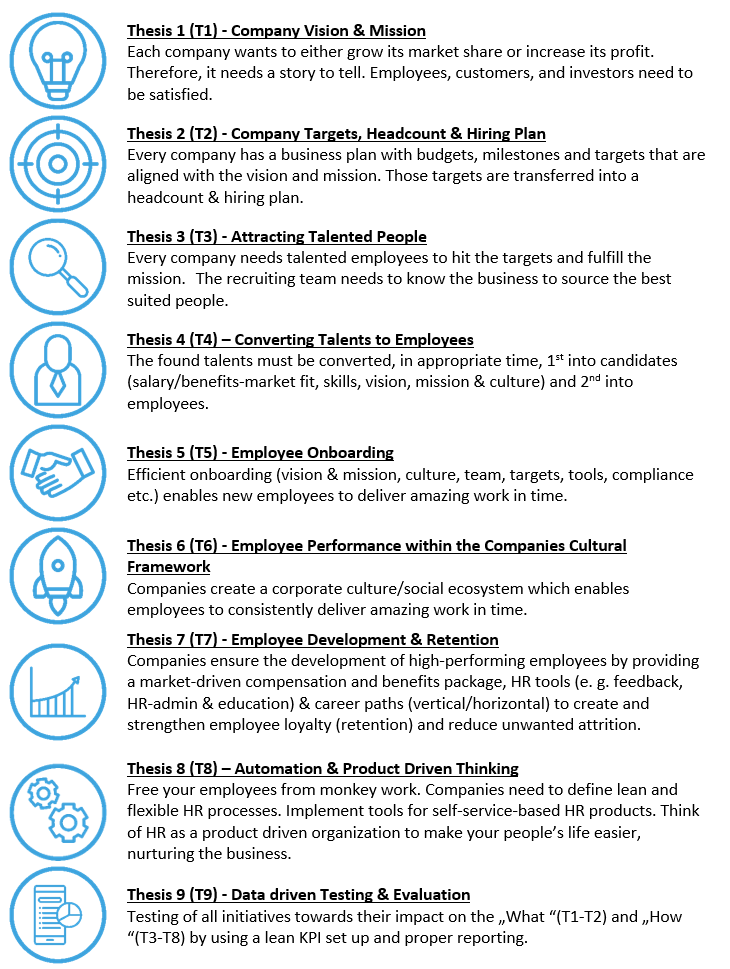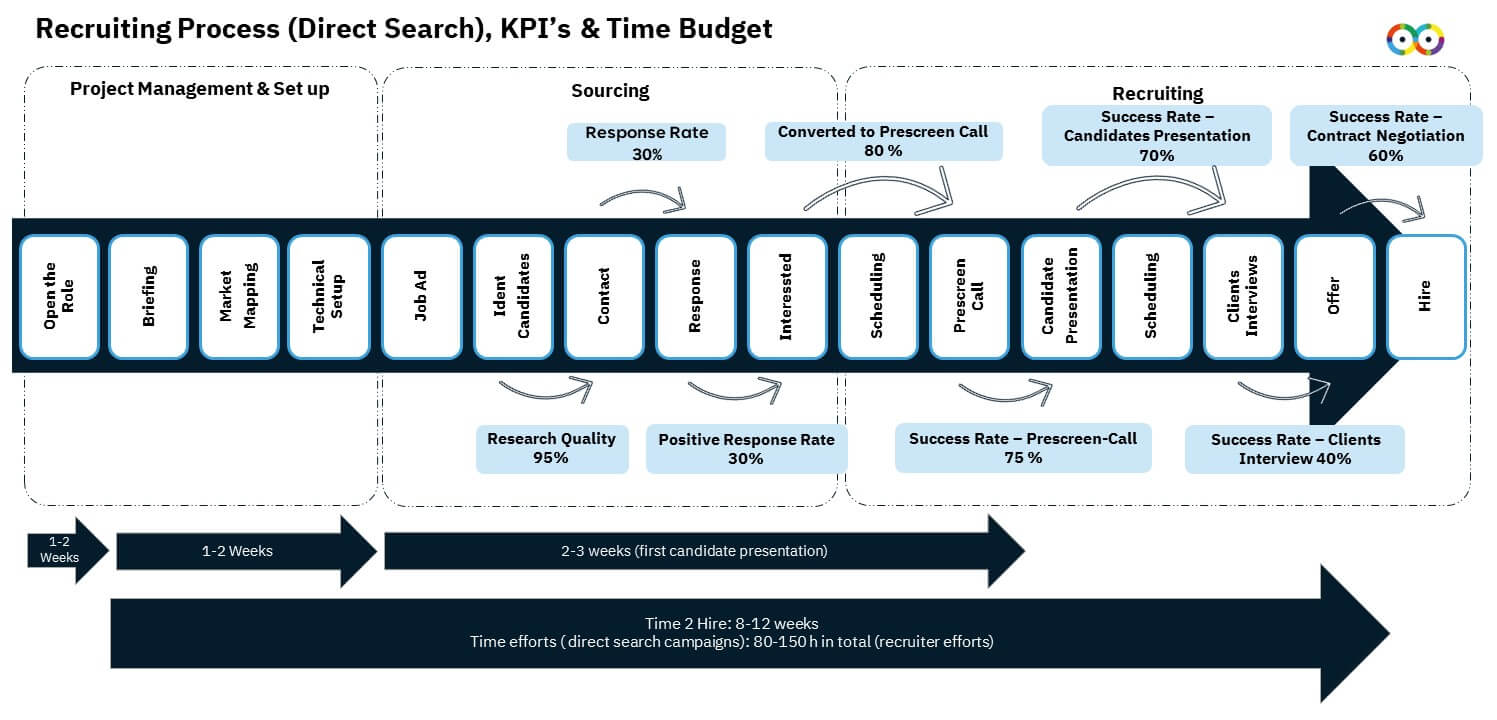Introduction
Table of Contents
A recruiter’s life can be a tough life: Everybody who is working in the recruiting domain will remember some hard times while getting the right candidate signed for a specific role. Facing a vacancy portfolio in the two digits numbers or suffering from dealing with too much administrative work, unclear process design, or lack of data blocking your way to success. Maybe your ATS is more an impediment than a supportive tool, or you need to deal with really brought role requirements, none of the candidates is matching with. We also all know situations where on the one hand the salary range deviates from candidate expectations, but on the other hand the C-Level is complaining about delays in staying on track with the hiring roadmap.
- We need the big picture before we dive into details. So let’s step back and focus on the core domains of HR, the recruiting subfunction inside, it’s dependencies and impact on the companies’ purpose and targets.
- We need to set up a professional data-driven and automized recruiting framework, including the recruiting process, technical setup and tools.
- We need to investigate the best practices to source the candidates you are looking for.
- We need to design an interview process to assess candidates in the best possible way.
- A case study of two comparable technical roles we have been able to fill.

Audience Group: This paper can be worth your attention if you belong to the following groups: Recruiting Leaders, Recruiters, Hiring Managers, holistic thinking HR Leaders, Business Owners and C-Level people as well as curious people in general.
Before we dig into details of recruitment, let’s have a short and holistic view at the HR function itself.
Part 1
The Nine HR-Theses Framework for Holistic Thinking People
Maybe a no-brainer, but recruiters are normally part of the HR function as one of the main facilitators of company success. Recruiters are dependent on proper business planning, a kind of stable hiring plan or at least corridor and enough resources and the right tools to attract talents, convert them to candidates and finally to employees.
But no matter how many candidates are piped in and converted to employees, the recruiter should always be close with the onboarding function and HR business partners, taking care of development and retention initiatives. If something goes wrong in those parts of the HR value chain, the recruiter may not run out of work, but rising unwanted attrition rates are harming the business.
All the HR initiatives shall be tested against the company targets. As a Recruiter you can use the data-driven way in forecasting your initiatives based on historical or market data. If you have a well-prepared recruiting dashboard (we are using an inhouse tool called DasHR) you can detect early, if things not working and to which channels you should allocate your resources. Finally have an eye on the attrition rate and root causes of unwanted attrition.
The following “Nine HR theses framework” shall give you some guidelines for the holistic thinkers in the Recruiting domain.
What do you think? If something is missing, just let me know. But let’s continue. Imagine that the business goals have been defined. The head count planning is done, and the hiring roadmap is finalized.
As a recruiting leader, recruiting operative or agency recruiter, it’s now time to think of a recruiting process.
Part 2
1. The Recruiting Process
Basically, the process should include three main ingredients.
Project Management: Including the request to fill a specific role, role briefing, market mapping and technical set up.
Sourcing: Including the job advertisement, identification of candidate, contacting candidates, responses by candidates & positive response rates.
Recruiting: Scheduling the prescreen call, pitching the company & role, candidate’s pre-assessment, introducing the candidate to the client/hiring manager, hiring managers/ client’s interview and candidate assessment, offer, hire and handover to the onboarding people.
Because pictures tell more than a thousand words, attached a process chart:
Some of the KPI’s may vary depended e.g. on the role you are recruiting for or the recruiting maturity of your organization. But if everything is optimized and everybody is aligned, you can use them as benchmark numbers.
1.1 Briefing
Each experienced recruiter will know most of the following ingredients of a well-served briefing to fill the vacant role. You are the chef! The hiring manager is your supplier for the finest information you need to get your Michelin star. Don’t just accept outdated information from an old briefing or just a call from an in-house recruiter. Would you prepare a meal with already used ingredients? Life changes constantly, so role requirements do as well. [2]
The industry, products, and organizational structure: Get an understanding of the company’s culture (communicated values vs. the real life), industry, trends, the products, competitors, financial situation, headcount development, turnover rate and voluntary attrition rate as well as the reasons behind. How is the company structured (departments, site locations and structural or personal based friction between the different people and groups relevant for the daily work of the new hire).
The role in general: You need to know the role name. Ideally not just the fancy name published in the job ad, but also ideally its position in the organization’s internal role and salary grid. Further things are, seniority, report line, leadership aspects, budget responsibility, location of work (on-site, hybrid, full remote), age & diversity needs [3].
New role or replacement: Most important, do we want to raise headcount, or do we need to replace someone? If this is the case, identify the attrition reasons. In the worst case you hire in a bad structure, burning the recruiting budget, while the attrition rate is rising instead of investing in structural changes or development initiatives for managers first.
Task & challenges: What are the hiring manager’s expectations towards the new hire’s accomplishments inside the first three, six, and twelve months? What are the top three initiatives the new hire shall take care of and scope of responsibility. How do these initiatives are contributing to the company’s mission, vision, product and targets?
Hard skills: We are talking about the requirements related to the scope of responsibility as well as core objectives. Identify what is mandatory to get the job done and what can be learned on the job. Try to carve out the nice-to-haves which could help the new hire, but are not crucial for the job to be done.
Social skills: You know the rock star syndrome? People who are top-notch in their domain but not giving a fxxx about anybody who is not crucial to their success. Be careful. You need to implement buffer institutions to absorb toxic behaviour before the social venom is spreading into the organization. If you hire rock stars, keep an eye on them to preemptively solve conflicts. Hire an HR person on top.
What I experienced is majorly the need for humble but hungry people. A mind set built on solution drivenness, communicating clearly and empathically, resilient to a certain amount of stress and emotionally balanced.
Hard facts: What type of contract is provided (unlimited, limited, or freelance)? About what kind of salary range we are talking and the position in the company’s salary grid? What does the whole package consist of? Gather the fixum, bonus, type of bonus, shares (e.g. hard shares, ESOP), vacation days, and hard benefits. Don’t let you distract by blurred things like flat hierarchies, kickers, or fresh fruits. We are talking about real benefits: e.g. remote or at least hybrid work options [4], educational budgets, flexible working hours, paid over hours, product discounts (depending on the product), a mobility program, relocation support, visa sponsorship & pension plan. The list is far from complete, but I guess you know what I mean.
Recruiting process: Make sure that the process, funnel steps, timeframes of interviews, case studies & jour fixes are aligned with the hiring managers and rest of the hiring team. The process design depends on the role. The baseline should be a prescreen & hiring manager interview, a case study and a bit bigger round including future colleagues and stakeholders, reference checks, offer call, contracting and signing. Normally, the recruiting function is handing it over to the onboarding people. Depending on the company’s headcount, multiple functions can be handled by the same person. Try to define one touchpoint for the recruiter who can be held responsible if difficult decisions need to be made. ³
[1] If you have the chance also get in touch with people inside the team, you are recruiting for and with the main stakeholders of the role. This allows you to cross-check the hiring manager’s information.
[2] Sure, if it’s a repeatedly recruited role you are familiar with, you do not need to enforce each time a new briefing call with the hiring manager, but nevertheless keep an eye on potential requirement changes.
[3] Of course, aligned with local labor restrictions.
[4] It depends on the role requirements, if you are looking for operational workers like production line people, this cannot be done from home. Let’s be honest, at least mostly all white-collar jobs can be done remotely. Make sure your company / client is not just offering working from home, but also has the right tools and processes in place to allow efficient virtual collaboration. I would love to tackle the productivity gap debate, but this will blow this paper.
1.1.1 Briefing Tools
Use a standardized briefing form, ideally already implemented in your ATS. Hand it over to your hiring manager before the briefing call with request to prefill. This will give your hiring manager the chance to contemplate what is really needed to get the job done, and you can go through the notes upfront, starting well-prepared into the conversation.
Here you can download a template for a Briefingsheet.
1.1.2 Briefing Intelligence
Role related eco system: If you need to recruit a technical role like e. g. a frontend developer, you should know about the differences between a frontend, backend and full stack developer. Also, basic knowledge about the types of seniority should be known. A Junior mostly works on defined tasks, coding tickets away. A senior instead may own parts or even a whole application technically, mentoring others, doing code reviews, or challenging the product owner.
Good to know how a tech organization is built and which other technical roles exists maybe overlapping with skills your recruit needs to have. What’s the difference between a frontend developer and the following roles: Software Architect, DevOps Engineer, Staff Engineer, Product Owner, UX/UI Designer, IT Admin, Software Tester or Product Owner? How they collaborate with each other and where tasks may overlap.
A software architect or QA automation engineer may have the similar buzzwords in their profiles/ cvs but probably will have a fully different scope of responsibilities.
This holistic but also domain specific knowledge will help to prescreen better.
Technology ecosystem If you are looking for e. g. a frontend developer (React, Typescript), it is good to know that React is a JavaScript framework and Java may sound the same but is an object oriented language on its own whereas the usual JavaScript is a script based language. Having in mind that TypeScript is derived from JavaScript one may think also of considering JavaScript Developer providing them a short ramp up on TypeScript.
I heavily recommend creating a tech ecosystems mind map or library to keep track with the technologies and their interdependencies.
Stay on a buzzword level and maybe one to two layers below. That’s enough to recruit the right people. Never try to get a deep understanding on code level, you will be quickly disappointed.
Recruiting channels: Assess the recruiting channels, you already have successfully filled vacancies like the ones you are recruiting for.
External Employer Branding platforms: Have an eye on your companies’ employer branding pages like e.g., kununu or glassdoor, because candidates also do. Be aware of the ratings of candidates and current as well as former employees. Ideally you get some intel about the department you are hiring for and how the company reacts on especially negative comments. No reaction is the worse reaction. Set up a platforms notification to get informed if something is happening there.
E-mail alerts: Set up an e-mail alert (e.g. google) with your company’s/ client’s name to get informed about any good or bad news. Smart candidates will do their research as well. In general, you should have an e-mail alert to get notified about mergers and acquisitions, lay off waves or insolvencies. Employees of affected companies will likely show interest in your job offer. Approach them.
Candidates’ personas: Define different kinds of candidate’s personas which could do the job. This will make your job much easier.
KPI’s: Check publicly available or historical recruiting KPI’s from similar successfully filled vacancies. The most common ones are Cost of Hire, Time-to-Hire, Time-to-fill, recruiting funnel ratios (e.g. Candidates-To-Hire, Response Rate or Offer Acceptance Rate).
Reporting: No matter whether you use the ATS onboarding reporting, Excel, BI tools or external solution: Have it in place to detect deviations from your forecast fast and come up with solution proposals to get back on track in time. Your hiring managers will appreciate this.
Prioritization by cost of vacancy: If you are leading an inhouse recruiting team or being a recruiter it’s not uncommon having to little manpower for all the vacancies to fill.
Ask for the estimated revenue per vacancy and loss of revenue each day a role stays vacant. This will help to prioritize getting roles on hold or freeing budget for external recruiting support.
1.2 Market Mapping
Salary range benchmarking: Map the given salary range with comparable roles you already have placed. Check your database or use publicly available data provided by kununu, glassdoor or gehalt.de.
Benefits benchmarking: Use e. g. job advertisements already published by your recruiting competitors, relevant to your recruiting region and role.
Candidates available: Benchmark the number of available candidates in your recruiting region on social media (e. g. LinkedIn or Xing) and be aware of the platforms different search engines and specific flaws. This can have a heavy impact on your search results.
Role fit: Is the role-market-fit given? Do comparable roles exist with same names and requirement or is an adjustment needed?
1.3 Recruiting Tools – Technical Set Up
Besides having the domain knowledge, a well working and automized recruiting tool landscape will make you work tremendously efficient. Prepare your engine!
1.3.1 ATS
Your ATS (Application tracking system) shall be the core of everything and your single source of truth. Try to keep all related recruiting data here and avoid other channels to prevent redundant data and maybe inconsistent information flows.
Application route: Keep the application process lean for actively looking candidates. Use 1 click apply features form e. g. LinkedIn or at least just request a cv. Times of mandatory motivation letters and other documents in the first place will simply reduce your number of inbound candidates.
Application form: If you have a blooming employer brand, struggling with the luxury problem of loads of inbound candidates or you are handling a vacancy portfolio in the 2 digits size think of an application form, candidates need to prefill before finishing the application process. Keep it lean and include starting date, salary expectation, language skills, current location and whether a working permission is given or not.
Pipeline design: Make sure you have a standardized recruiting pipeline mirroring the used recruiting process including the sourcing part as well as the recruiting process.
E-mail templates: Standardize your communication having e-mail templates in place for the most common use cases as well as automized e-mails by trigger events (confirmation of application or rejection mails after rejecting a candidate).
Scorecards: Prepare briefing based scorecards, which should be the main tool for candidates’ evaluation. Make sure that the hiring managers approve them and keep using them. Keep them lean, based on the core criteria. Decide, whether you integrate weights or simply use the sum of pro & cons.
Role management: The full potential of an ATS depends on the role management and upfront decision of data accessibility. Most companies, e.g., want to avoid making the salary expectation transparent for all hiring team members. This shall be included in the roles management capabilities.
Data compliance: Depending on the site location you are recruiting for, your ATS shall be data compliant to the local data protection laws and this shall be documented accessible for candidates. Before you implement your ATS make sure, that a data protection specialist has certified your process.
Reporting: Get yourself familiar with the reporting capabilities of your ATS and use them. If the reporting functionalities are limited talk to your Marketing or Data Team for first Excel prototypes or build them on your own. Manual snap shots are fine in the first place. If you decide to continue with Excel or any other external tool, make yourself familiar with your ATS’ data export functionalities/ APIs. Skill yourself up regarding basics in Excel ETL routines and feed your Excel Recruiting Dashboard. Another choice could be an external dashboard solution or a Dashboard built by your BI Team. Also think of considering a reporting upgrade of your ATS License or consider a different system with more sophisticated onboard reporting functionalities. Set up (weekly) targets.
1.3.2 Integrations
Career page: The job board of your ATS should be integrated into your career page. Wow, what an enlightenment, right? Some ATS vendors offer integrated career pages, which you can easily create via drag and drop. No coding skills required. Some vendors offer Iframes, some others simply offer an API. So, you need to create your career page on your own. If this is the case, you need coding skills. I can recommend using some common CMS like WordPress and keep an eye on the APIs. So that candidates always can apply.
But where to put the career page’s button/link to your company’s product page? The header, right, you want it in the header?
Unfortunately, mostly the product-, marketing- or salespeople are no fan of integrating the career page button in the header of the product main page, fearing that the online-marketing budget will get wasted by customers who maybe turn into candidates. So mostly you will find the career page link somewhere in the footer. But even if so, make sure that the job board is prominently positioned on top of your main career landing page.
Scheduling: The easiest way to get efficient is an ATS capability to integrate a video conferencing tool, a self-scheduling tool for candidates integrated with the hiring teams calendars and meeting rooms, when onsite meetings are needed. Scheduling appointments manually is time consuming monkey work. Avoid wasting resources for ping pong mails and calling the candidate. Your candidates will appreciate choosing time slots on their own. You also save their time.
Job spreader & Job boards: Spreading the job with one click to multiple job boards is a time saver. Do you remember the time when you needed to send PDF documents to job board providers, having endless e-mails to get it published the way you need it? Some ATS includes shop functionalities where you can directly buy job slots on different kind of job boards. Ideally your ATS provider or the integrated vendor can offer discounts based on his purchasing power as a reseller.
CV/profile parser: If your ATS provides integrations with your preferred Direct Search Tools, use them. LinkedIn e.g., offers an API for LinkedIn recruiter seats to automatically import the profile links to partnering ATS providers. Much easier than importing profiles manually to your ATS. There are also Browser extensions, which can help. If there is no API existing, make sure your ATS has a well working parser functionality for multiple profiles upload at the same time.
Hiring team communication: Try to keep the communication ideally in the ATS for documentation reasons. Most ATS offer comment functions. Try to bring everybody in and introduce them to the notification management of your ATS. Everybody should just get an e-mail notification if her/his feedback is needed.
Outlook
After we have focused on the Nine HR Theses Framework, had a look at the recruiting process and tooling, in the following blog we will investigate how to effectively source candidates.
See you soon.







